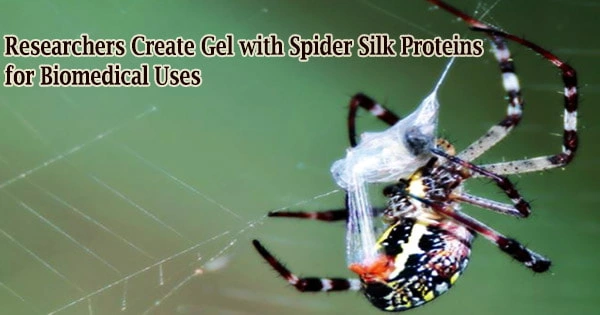Researchers at the Swedish University of Agricultural Sciences and the Karolinska Institutet in Sweden have found that spider silk proteins can be bonded to biologically active proteins and be transformed into a gel at body temperature.
One of the objectives is to create an injectable protein solution that solidifies inside the body, which might be utilized for tissue engineering, medication release, and the production of gels that can speed up chemical reactions involving enzymes. Published in Nature Communications is the study.
“We have developed a completely new method for creating a three-dimensional gel from spider silk that can be designed to deliver different functional proteins,” says Anna Rising, research group leader at the Department of Biosciences and Nutrition, Karolinska Institutet (KI) and professor at the Department of Anatomy, Physiology, and Biochemistry, Swedish University of Agricultural Sciences (SLU). “The proteins in the gel are very close together and the method is so mild that it can be used even for sensitive proteins.”
An injectable protein solution
The scientists intend to create an injectable protein solution that solidifies into a gel inside the body in the future. Creating hydrogels with specific functionalities paves the way for a variety of potential uses.
An example of how such a gel might be applied is to produce a controlled release of medication into the body. It might combine with enzymes, a class of proteins employed in the chemical industry to speed up various chemical processes.
We have developed a completely new method for creating a three-dimensional gel from spider silk that can be designed to deliver different functional proteins. The proteins in the gel are very close together and the method is so mild that it can be used even for sensitive proteins.
Anna Rising
“In the slightly longer term, I think injectable gels can become very useful in regenerative medicine,” says the study’s first author Tina Arndt, PhD student in Anna Rising’s research group at Karolinska Institutet.
“We have a long way to go, but the fact that the protein solution quickly forms a gel at body temperature and that the spider silk has been shown to be well tolerated by the body is promising.”
Mimics spider silk spinning
The chemical principles underpinning how spiders are able to spin extraordinarily strong fibers from a solution of silk protein in a matter of nanoseconds have attracted attention. The capacity of the spiders to maintain proteins soluble so that they do not collect before the spinning of the spider silk has captured the attention of scientists at KI and SLU.
They’ve already created a technique for making valuable proteins that imitates the way a spider makes and stores the proteins in its silk.
“We have previously shown that a specific part of the spider silk protein called the N-terminal domain is produced in large quantities and can keep other proteins soluble, and we can exploit this for medical applications,” says Anna Rising.
“We have let bacteria produce this part of the protein linked to functional proteins, including various drugs and enzymes.”
Transformed into a gel
According to the latest research, the N-terminal domain can also change shape and transform into tiny fibrils, which, when incubated at 37 °C, allow the protein solution to solidify into a gel.
In addition, it can be fused to functional proteins that preserve their function in the gel.
The research was funded by the European Research Council (ERC), the Centre for Innovative Medicine (CIMED) at Karolinska Institutet and Region Stockholm, the Strategic Research Area of Stem Cells and Regenerative Medicine at Karolinska Institutet, the Swedish Research Council, the European Regional Development Fund and the Novo Nordisk Foundation.
The study was also conducted using the core facility Biomedicum Imaging Core (BIC) at Karolinska Institutet. The researchers state that there are no conflicts of interest.





